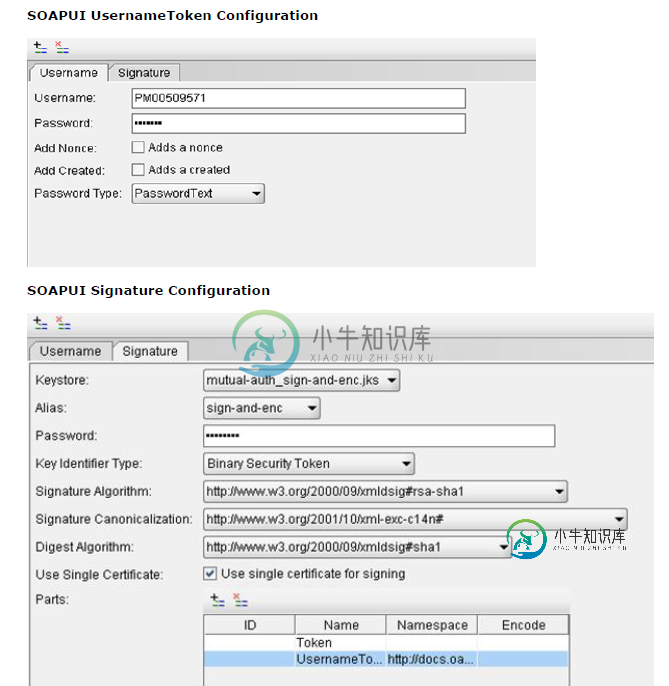如何使WCF客户端符合特定WS-Security-签名UsernameToken和SecurityTokenReference
我需要创建一个wcf客户端来调用一个我无法控制的服务。
我得到了一个wsdl和一个工作中的soapui项目。
该服务同时使用用户名/密码和x509证书。
我用来创建要插入到安全头中的签名块的代码如下所示
string certificatePath = System.Windows.Forms.Application.StartupPath + "\\" + "Certs\\sign-and- enc.p12";
XmlDocument xd = new XmlDocument();
xd.LoadXml(xml);
// Set Certificate
System.Security.Cryptography.X509Certificates.X509Certificate2 cert = new X509Certificate2(certificatePath, "password");
MySignedXml signedXml = new MySignedXml(xd);
signedXml.SigningKey = cert.PrivateKey;
// Create a new KeyInfo object.
KeyInfo keyInfo = new KeyInfo();
keyInfo.Id = "";
MemoryStream keyInfoStream = new MemoryStream();
XmlWriter keyInfoWriter = XmlWriter.Create(keyInfoStream);
WSSecurityTokenSerializer.DefaultInstance.WriteKeyIdentifierClause(keyInfoWriter, new LocalIdKeyIdentifierClause("token_reference", typeof(X509SecurityToken)));
keyInfoWriter.Flush();
keyInfoStream.Position = 0;
XmlDocument keyInfoDocument = new XmlDocument();
keyInfoDocument.Load(keyInfoStream);
XmlAttribute attrib = keyInfoDocument.CreateAttribute("ValueType");
attrib.InnerText = "http://docs.oasis-open.org/wss/2004/01/oasis-200401-wss-x509-token-profile-1.0#X509v3";
keyInfoDocument.ChildNodes[1].ChildNodes[0].Attributes.Append(attrib);
KeyInfoNode keyInfoNode = new KeyInfoNode();
keyInfoNode.LoadXml(keyInfoDocument.DocumentElement);
keyInfo.AddClause(keyInfoNode);
// Add the KeyInfo object to the SignedXml object.
signedXml.KeyInfo = keyInfo;
// Need to use External Canonicalization method.
signedXml.SignedInfo.CanonicalizationMethod = "http://www.w3.org/2001/10/xml-exc-c14n#";
// Create a reference to be signed.
Reference reference = new Reference();
reference.Uri = "#UsernameToken-1";
XmlDsigEnvelopedSignatureTransform env = new XmlDsigEnvelopedSignatureTransform();
env.Algorithm = "http://www.w3.org/2001/10/xml-exc-c14n#";
reference.AddTransform(env);
reference.DigestMethod = "http://www.w3.org/2000/09/xmldsig#sha1";
signedXml.AddReference(reference);
Reference reference2 = new Reference();
reference2.Uri = "#token_reference";
XmlDsigEnvelopedSignatureTransform env2 = new XmlDsigEnvelopedSignatureTransform();
env2.Algorithm = "http://www.w3.org/2001/10/xml-exc-c14n#";
reference2.AddTransform(env2);
reference2.DigestMethod = "http://www.w3.org/2000/09/xmldsig#sha1";
signedXml.AddReference(reference2);
// Add the Signature Id
signedXml.Signature.Id = "MYSIG_ID";
// Compute the signature.
signedXml.ComputeSignature();
XmlElement xmlDigitalSignature = signedXml.GetXml();
其中,xml变量是UsernameToken xml字符串,MySignedXml类是一个子类SignedXml,重写了GetIdElement方法(尝试查找并正确引用不存在的SecurityTokenReference)
我已经花了几天的时间来研究和测试,不幸的是,提供服务的公司没有任何帮助--但我需要使用他们的服务。
<soapenv:Envelope xmlns:soapenv="http://schemas.xmlsoap.org/soap/envelope/" xmlns:urn="urn:XXXXX">
<soapenv:Header xmlns:ebxml="http://docs.oasis-open.org/ebxml-msg/ebms/v3.0/ns/core/200704/">
<wsse:Security soapenv:mustUnderstand="1" xmlns:wsse="http://docs.oasis-open.org/wss/2004/01/oasis-200401-wss-wssecurity-secext-1.0.xsd">
<wsse:BinarySecurityToken EncodingType="http://docs.oasis-open.org/wss/2004/01/oasis-200401-wss-soap-message-security-1.0#Base64Binary" ValueType="http://docs.oasis-open.org/wss/2004/01/oasis-200401-wss-x509-token-profile-1.0#X509v3" wsu:Id="CertId-D05E596B5ABC341FEB13505090224061" xmlns:wsu="http://docs.oasis-open.org/wss/2004/01/oasis-200401-wss-wssecurity-utility-1.0.xsd">MIIEnDCCBAWgAwIBAgIBAjANBgkqhkiG9w0BAQUFADCBxDELMAkGA1UEBhMCTloxDTALBgNVBAgTBFdHVE4xEzARBgNVBAcTCldlbGxpbmd0b24xGDAWBgNVBAoTD0lSRFN0dWR5bGlua0IyQjEUMBIGA1UECxMLRGV2ZWxvcG1lbnQxHjAcBgNVBAMTFWRldmNhLmIyYi5pcmQuZ292dC5uejEXMBUGA1UEKRMORGV2ZWxvcG1lbnQgQ0ExKDAmBgkqhkiG9w0BCQEWGWNocmlzLnNjaHVsdHpAaXJkLmdvdnQubnowHhcNMTEwOTE1MDIwNjIwWhcNMjEwOTEyMDIwNjIwWjCByTELMAkGA1UEBhMCTloxDTALBgNVBAgTBFdHVE4xEzARBgNVBAcTCldlbGxpbmd0b24xGDAWBgNVBAoTD0lSRFN0dWR5bGlua0IyQjEUMBIGA1UECxMLRGV2ZWxvcG1lbnQxJTAjBgNVBAMTHHNpZ24tYW5kLWVuYy5kZXYuaXJkLmdvdnQubnoxFTATBgNVBCkTDHNpZ24tYW5kLWVuYzEoMCYGCSqGSIb3DQEJARYZY2hyaXMuc2NodWx0ekBpcmQuZ292dC5uejCBnzANBgkqhkiG9w0BAQEFAAOBjQAwgYkCgYEAykyZHVnXjsG220zB3kNOsGBeGP2rdNbLlIqW1D8yZO1fcj3/RhRiqsopbUrb8AU1ClpfhbH2K68kg7V91VAY0qrwNxP+pPPo1vYKMU6pT38qJGQzffr+iV2BCJshZvSk9E7QSWO5mFNstdg19xc+5ST1Lgb3fefuRG2KZVxPx0sCAwEAAaOCAZUwggGRMAkGA1UdEwQCMAAwEQYJYIZIAYb4QgEBBAQDAgZAMDQGCWCGSAGG+EIBDQQnFiVFYXN5LVJTQSBHZW5lcmF0ZWQgU2VydmVyIENlcnRpZmljYXRlMB0GA1UdDgQWBBSczRKXKPe3Sin7eFrVXfI7MXckzzCB+QYDVR0jBIHxMIHugBSLWxPSZd9otEj16vhLyovMCI9OMaGByqSBxzCBxDELMAkGA1UEBhMCTloxDTALBgNVBAgTBFdHVE4xEzARBgNVBAcTCldlbGxpbmd0b24xGDAWBgNVBAoTD0lSRFN0dWR5bGlua0IyQjEUMBIGA1UECxMLRGV2ZWxvcG1lbnQxHjAcBgNVBAMTFWRldmNhLmIyYi5pcmQuZ292dC5uejEXMBUGA1UEKRMORGV2ZWxvcG1lbnQgQ0ExKDAmBgkqhkiG9w0BCQEWGWNocmlzLnNjaHVsdHpAaXJkLmdvdnQubnqCCQDL/qDdlx2j6DATBgNVHSUEDDAKBggrBgEFBQcDATALBgNVHQ8EBAMCBaAwDQYJKoZIhvcNAQEFBQADgYEAS4ZPIVVpgTOGN4XcIC3SiYlxF8wYg7qnUhH5wJsAD3VCKfj68j9FSJtdBWLlWvvRxEoDP2lZ0IbFl6Rjnl+2ibzFnyac2G1AVm5mwPrNKHBQJ9J5eDJi0iUVY7Wphz86tKnqj34GvlHPNXmrF7oGEcDhPwK0T8zRdE/pvKIUiJc=</wsse:BinarySecurityToken>
<ds:Signature Id="Signature-2" xmlns:ds="http://www.w3.org/2000/09/xmldsig#">
<ds:SignedInfo>
<ds:CanonicalizationMethod Algorithm="http://www.w3.org/2001/10/xml-exc-c14n#"/>
<ds:SignatureMethod Algorithm="http://www.w3.org/2000/09/xmldsig#rsa-sha1"/>
<ds:Reference URI="#CertId-D05E596B5ABC341FEB13505090224061">
<ds:Transforms>
<ds:Transform Algorithm="http://www.w3.org/2001/10/xml-exc-c14n#"/>
</ds:Transforms>
<ds:DigestMethod Algorithm="http://www.w3.org/2000/09/xmldsig#sha1"/>
<ds:DigestValue>3iVAUEAt8vAb7Ku+jf2gwSkSm0Q=</ds:DigestValue>
</ds:Reference>
<ds:Reference URI="#UsernameToken-1">
<ds:Transforms>
<ds:Transform Algorithm="http://www.w3.org/2001/10/xml-exc-c14n#"/>
</ds:Transforms>
<ds:DigestMethod Algorithm="http://www.w3.org/2000/09/xmldsig#sha1"/>
<ds:DigestValue>r4HLEAWJldJwmEmcAqV6Y8rnTPE=</ds:DigestValue>
</ds:Reference>
</ds:SignedInfo>
<ds:SignatureValue>
YGh2I3VcukqjT0O7hKItiykWN5tlID18ZXRCwQjXriHmnVsO4wGcHjWfmhuNDecq+xRN+SjG8E7M
2Rx/5/BbFKbVlNOkQOSbSxIs1YT9GaThK16pMrX5KRkkJme1W3R0pGIIQh6gGRSUf79RZUIYxyVl
LqdIe561TXXDdtbt/6Q=
</ds:SignatureValue>
<ds:KeyInfo Id="KeyId-D05E596B5ABC341FEB13505090224372">
<wsse:SecurityTokenReference wsu:Id="STRId-D05E596B5ABC341FEB13505090224373" xmlns:wsu="http://docs.oasis-open.org/wss/2004/01/oasis-200401-wss-wssecurity-utility-1.0.xsd">
<wsse:Reference URI="#CertId-D05E596B5ABC341FEB13505090224061" ValueType="http://docs.oasis-open.org/wss/2004/01/oasis-200401-wss-x509-token-profile-1.0#X509v3"/></wsse:SecurityTokenReference>
</ds:KeyInfo>
</ds:Signature>
<wsse:UsernameToken wsu:Id="UsernameToken-1" xmlns:wsu="http://docs.oasis-open.org/wss/2004/01/oasis-200401-wss-wssecurity-utility-1.0.xsd">
<wsse:Username>XXXXXX</wsse:Username>
<wsse:Password Type="http://docs.oasis-open.org/wss/2004/01/oasis-200401-wss-username-token-profile-1.0#PasswordText">XXXXXXX</wsse:Password>
</wsse:UsernameToken>
</wsse:Security>
<ebxml:Messaging xmlns:xsi="http://www.w3.org/2001/XMLSchema-instance">
<ebxml:UserMessage>
<ebxml:MessageInfo>
<ebxml:Timestamp>2002-02-02T14:18:02.0Z</ebxml:Timestamp>
<ebxml:MessageId>bf9433d9-c6e9-4c12-9c98-724008a09c21</ebxml:MessageId>
</ebxml:MessageInfo>
<ebxml:PartyInfo>
<ebxml:From>
<ebxml:PartyId type="identifier">Trading Partner X</ebxml:PartyId>
<ebxml:Role>Provider</ebxml:Role>
</ebxml:From>
<ebxml:To>
<ebxml:PartyId type="identifier">XXXXXXX</ebxml:PartyId>
<ebxml:Role>Requestor</ebxml:Role>
</ebxml:To>
</ebxml:PartyInfo>
<ebxml:CollaborationInfo>
<ebxml:AgreementRef>urn:XXXXXXXXX</ebxml:AgreementRef>
<ebxml:Service type="Web Service">urn:XXXXXXXX</ebxml:Service>
<ebxml:Action>customerInformation</ebxml:Action>
<ebxml:ConversationId>e302426a-b2d9-4ff1-a14b-fbbc2f40a017</ebxml:ConversationId>
</ebxml:CollaborationInfo>
</ebxml:UserMessage>
</ebxml:Messaging>
</soapenv:Header>
<soapenv:Body>
<urn:ConnectionTest>
<Message>Bonjour</Message>
</urn:ConnectionTest>
</soapenv:Body>
</soapenv:Envelope>
将与用于签名的私钥匹配的证书包含为wsse:BinarySecurityToken,并将其用作签名的wsse:SecurityTokenReference

共有1个答案
今天终于解决了问题。就术语而言,我需要签名的不是SecurityTokenReference,而是二进制安全令牌。
为此,我需要隐藏发起方和接收方的证书,并添加一个签名的支持令牌。
我回到使用配置来创建和签名消息,而不是尝试手动添加签名。
private System.ServiceModel.Channels.Binding GetCustomBinding()
{
System.ServiceModel.Channels.AsymmetricSecurityBindingElement asbe = new AsymmetricSecurityBindingElement();
asbe.MessageSecurityVersion = MessageSecurityVersion.WSSecurity11WSTrust13WSSecureConversation13WSSecurityPolicy12;
asbe.InitiatorTokenParameters = new System.ServiceModel.Security.Tokens.X509SecurityTokenParameters { InclusionMode = SecurityTokenInclusionMode.Never };
asbe.RecipientTokenParameters = new System.ServiceModel.Security.Tokens.X509SecurityTokenParameters { InclusionMode = SecurityTokenInclusionMode.Never };
asbe.MessageProtectionOrder = System.ServiceModel.Security.MessageProtectionOrder.SignBeforeEncrypt;
asbe.SecurityHeaderLayout = SecurityHeaderLayout.Strict;
asbe.EnableUnsecuredResponse = true;
asbe.IncludeTimestamp = false;
asbe.SetKeyDerivation(false);
asbe.DefaultAlgorithmSuite = System.ServiceModel.Security.SecurityAlgorithmSuite.Basic128Rsa15;
asbe.EndpointSupportingTokenParameters.Signed.Add(new UserNameSecurityTokenParameters());
asbe.EndpointSupportingTokenParameters.Signed.Add(new X509SecurityTokenParameters());
CustomBinding myBinding = new CustomBinding();
myBinding.Elements.Add(asbe);
myBinding.Elements.Add(new TextMessageEncodingBindingElement(MessageVersion.Soap11, Encoding.UTF8));
HttpsTransportBindingElement httpsBindingElement = new HttpsTransportBindingElement();
httpsBindingElement.RequireClientCertificate = true;
myBinding.Elements.Add(httpsBindingElement);
return myBinding;
}
代码的使用如下
using (CredentialingService.SOAPPortTypeClient client = GetCredentialingClient())
{
client.Open();
etc....
}
private static CredentialingService.SOAPPortTypeClient GetCredentialingClient()
{
CredentialingService.SOAPPortTypeClient client = new CredentialingService.SOAPPortTypeClient(GetCustomBinding(), new EndpointAddress(new Uri(Settings.AppSettings.B2BUrl), new DnsEndpointIdentity(Settings.AppSettings.B2BDNSEndpoint), new AddressHeaderCollection()));
client.Endpoint.Contract.ProtectionLevel = System.Net.Security.ProtectionLevel.None;
SetClientCredentialsSecurity(client.ClientCredentials);
return client;
}
在我的文章中指定了GetCustomBinding
SetClientCredentialsSecurity是设置证书的地方,如下所示
private static void SetClientCredentialsSecurity(ClientCredentials clientCredentials)
{
clientCredentials.UserName.UserName = Settings.AppSettings.B2BUserName;
clientCredentials.UserName.Password = Settings.AppSettings.B2BPassword;
string directoryName = Path.GetDirectoryName(System.Reflection.Assembly.GetExecutingAssembly().Location);
clientCredentials.ServiceCertificate.DefaultCertificate = new X509Certificate2(Path.Combine(directoryName, Settings.AppSettings.B2BServerCertificateName));
clientCredentials.ClientCertificate.Certificate = new X509Certificate2(Path.Combine(directoryName, Settings.AppSettings.B2BClientCertificateName), Settings.AppSettings.B2BClientCertificatePassword);
}
-
我想知道如何在WebSphere Liberty中启用WS-Security 我在Liberty个人资料的server.xml中创建了一个用户(soa_user)和用户组(soa_group)。下面提到的所有功能都已成功安装。 server.xml 我有两个模块,一个用于生成EAR(ABCServiceEAR)文件,另一个是SOAPService(ABCSOAPService) 在src \ ma
-
web服务提供者共享了soap消息的原始xml以突出显示ws-security头。使用soapUI,我已经能够创建完全相同的wsse-Security头,如下所示: 在soapUI中,在“WS-Security Configurations”下,我添加了密钥库(带有我的私有证书的jks)和信任库(带有CA根公钥的jks)。最后,我添加了带有以下设置的“传出WS-Security配置”。 使用此WS
-
我正在努力做一些基本的事情,但我的头脑还没有完全清醒过来。我有一个spring boot应用程序,它应该公开一个rest url。 我是这样做的: 正如您所见,它使用的是另一个服务,我正试图用一个外部客户机实现该服务: 界面看起来像: 当MdmhClient在调用: 我知道要解决这个问题,我需要将证书导入jre。我正在运行Intellij IDE,并将项目的jdk路径设置为: 我还通过firefo
-
我正在尝试调用一个web服务,并使用MTOM向我的请求添加一个附件。在我调用的web服务上启用了Mtom,并且我可以使用SOAPUI正常调用该服务。 请求的模式如下所示; 然后在我的java代码中创建jaxb请求对象并尝试从字符串中设置内容; 我已经将我的封送器设置为启用了mtom(尽管我不确定这在客户端上是必要的); 但我得到以下例外情况; 有没有人知道我做错了什么,或者有没有人能给我演示一个如
-
我有一个Web服务,我试图使用以下客户端代码调用它: 在服务器端(Tomcat),webservice实现如下: CxfAdd。java: CxfAddImpl。java: 但是,当我运行客户端代码时,在服务器端我得到以下错误: 似乎我没有发送ws-addressing属性,有人能帮我找出代码中的错误或缺失吗?非常感谢。
-
我正试图从一个服务器调用ws-security安全的Web服务,不幸的是,该服务器本机不支持此功能。我采取的方法是实施一个。jsp作为实际endpointURL的反向代理,在添加带有ws-security元素的元素的过程中。 这似乎运行得很好,我相信我已经用正确的命名空间正确地构建了XML。我已经通过比较XML和SOAP-UI产生的XML来验证了这一点。 问题是在实现密码摘要生成器时。我没有得到与

